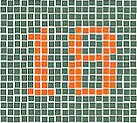- Skip Storing This Everyday Product in the Fridge Door
- Green Tea + B3 Pairing May Boost Brain Health
- Navigating Your Midlife Crisis: Embracing New Possibilities
- City Raccoons Showing Signs of Domestication
- Mapping the Exposome: Science Broadens Focus to Environmental Disease Triggers
- One Week Less on Social Media Linked to Better Mental Health
- Your Brain Changes in Stages as You Age, Study Finds
- Some Suicide Victims Show No Typical Warning Signs, Study Finds
- ByHeart Formula Faces Lawsuits After Babies Sickened With Botulism
- Switch to Vegan Diet Could Cut Your Greenhouse Gas Emissions in Half
Color Vision Tends to Fade With Age: Study


Here’s one more ability that seems to decline with age: color sense. A new study finds that many people lose their ability to clearly distinguish certain colors as they age, with losses typically starting around age 70 and getting worse over time.
But there’s good news too: In general, the loss of color vision in seniors doesn’t seem to affect day-to-day life.
Still, the findings raise issues about whether assumptions about the lack of problems are true. “[The decline] is probably not detrimental in their lives in any way, but that’s the next question: What are the practical implications of these findings?” said study lead author Marilyn Schneck, a scientist with the Smith-Kettlewell Eye Research Institute, in San Francisco. “There’s another question: What in the visual system is causing these changes?”
Researchers have long known that color vision can deteriorate as people get older, Schneck said. The lenses of their eyes can become yellowish, causing them to see as if they were looking through a yellow filter, she said. This can disrupt their so-called “blue-yellow” vision, preventing them in certain situations from distinguishing blue from purple and yellow from green and yellow-green. Problems are especially apparent when colors are washed out, Schneck said.
This is different from inherited colorblindness, which is more common among men and prevents people from distinguishing red from green.
In the new study, researchers sought to understand how common the color-vision problems are among older people. They gave tests to nearly 900 people aged 58 to 102 from the Northern California enclave of Marin County, leaving out anyone who had inherited colorblindness.
Color-vision problems in the blue-yellow spectrum affected 45 percent of people in their mid-70s, and that proportion rose to two-thirds by the time people reached their mid-90s. Few people had problems with the red-green spectrum.
Can these people restore their old color vision? Cataract surgery can make major difference because it replaces lenses in the eyes, clearing away the yellowish film, Schneck said. But, she said, the problems don’t appear to be fixable with glasses.
As for causes, Schneck said they appear to be cataracts, retinal disease and normal aging, although she said more research is needed to better pinpoint what’s going on.
Michael Crognale, director of cognitive and brain science with the department of psychology at the University of Nevada, Reno, cautioned that changes in color vision can be a sign of significant medical problems, such as diabetes.
“If you notice changes in your color vision, and it’s happening rapidly, that should be a warning flag for you to get your blood sugar tested and see an ophthalmologist about whether you’ve got retinal damage,” Crognale said.
As for preventing loss of color vision due to aging, forget it. That’s the word from Stephen Dain, who studies color vision as a professor with the School of Optometry and Vision Science at the University of New South Wales, in Sydney, Australia. Deterioration of color vision is “as inevitable as death and taxes,” he said.
The study appears in the March issue of the journal Optometry and Vision Science.
More information
For details about eye health in people over 60, try the American Optometric Association.
Source: HealthDay
Copyright © 2025 HealthDay. All rights reserved.










